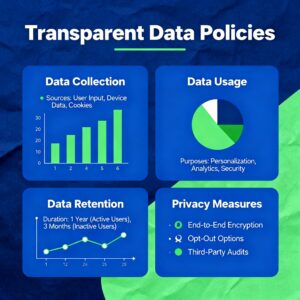Summary
User trust is the foundation for the successful adoption of new technology. Without trust, even the most advanced tools fail to deliver their potential. This blog explains actionable strategies to enhance user trust and drive the user adoption of new technology. By focusing on clear communication, transparency, user control, ethical practices, training, and continuous support, organizations can ensure that users embrace technology confidently and willingly.
Communicate Clear Purpose and Benefits
Communicating the purpose and benefits of new technology is the first step to building user trust. Users need to understand why a technology is implemented and how it will improve their workflow or daily life. Clear communication ensures that users see the value in the technology and are motivated to adopt it.
For example, if a company introduces a new project management tool, employees should know that it will help track tasks efficiently, reduce manual errors, and save time. Explaining tangible benefits like increased productivity, better team coordination, or easier reporting makes users more willing to engage.
Leadership must share this information through multiple channels, including emails, internal meetings, and short videos. Simple, concise, and clear messages help users quickly grasp the benefits without feeling overwhelmed.
Transparent Policies and Data Handling

Trust depends heavily on transparency. Users want to know how their data is collected, stored, and used. Transparent policies show that an organization respects users’ privacy and security.
Provide a clear, easy-to-understand summary of data handling policies. Use charts, infographics, or simple bullet points to explain:
- What data is collected.
- How the data will be used.
- How long the data will be retained.
- How data security is maintained.
Publishing a “data promise” or similar document builds confidence. Users who understand that their personal data is protected and handled responsibly are more likely to engage with new technology. Transparency reduces fear, increases trust, and encourages the user adoption of new technology.
Empower Users with Control Options

Users feel more confident when they have control over technology. Providing opt-in and opt-out options allows users to choose the features they want to use.
For example, a new communication platform may have multiple features like chat, video calls, and file sharing. Let users select which features they want to enable. Periodically remind users that they can change their preferences.
User autonomy demonstrates respect for individual choices. It also reassures users that they are not forced into adopting technology, which enhances trust and increases long-term engagement.
Engage Users Early Through Change Management

Early engagement is critical for successful technology adoption. Involve users in pilot programs, surveys, and feedback sessions before full rollout.
Engaging users early helps identify potential challenges and resistance. Feedback collected during this phase can guide adjustments, making the technology more user-friendly. Users who participate in the process feel a sense of ownership and are more likely to adopt the technology willingly.
Change management strategies, such as focus groups or pilot testing, help organizations address concerns proactively. Early involvement ensures smoother transitions and higher adoption rates.
Also Read:The Benefits of Biometric Access Control
Comprehensive Training and Continuous Learning
Training is essential for users to feel comfortable and confident with new technology. Without proper training, users may resist adoption due to fear or uncertainty.
Provide multiple training formats to accommodate different learning styles, including:
- Hands-on workshops
- Online courses
- Video tutorials
- One-on-one coaching
Training should not stop after initial rollout. Offer refresher sessions and advanced courses to help users fully utilize the technology. Continuous learning ensures that users remain confident and competent, improving both engagement and the user adoption of new technology.
Appoint Technology Champions
Technology champions are early adopters who can guide others. They act as peer mentors and help users navigate new tools.
Champions can provide on-the-spot assistance, answer questions, and share best practices. They also relay feedback from users to leadership, helping improve the technology experience.
Having champions across departments ensures consistent support and motivates others to adopt technology. Their enthusiasm often spreads, encouraging broader user adoption and engagement.
Proactive Communication and Feedback Loops
Regular, transparent communication keeps users informed and builds trust. Provide updates on rollout progress, feature improvements, and any challenges encountered.
Create channels for feedback, such as:
- Surveys
- Helpdesk support
- Internal forums
Listening to users and responding promptly shows that their opinions matter. Incorporating their feedback into improvements strengthens trust and encourages more users to adopt the technology confidently.
Address Resistance Proactively
Resistance is a natural response to change. Users may fear learning new skills, losing control, or being overwhelmed by new processes.
Identify the root causes of resistance and address them directly. Offer additional training, reassurance, and personalized support. Show empathy and understanding to reduce anxiety and foster a positive attitude toward the technology.
Proactively addressing resistance helps users feel supported, enhancing trust and accelerating user adoption of new technology.
Ethical Considerations in Technology Deployment
Ethical practices influence user trust. Users want to know that technology is used responsibly, fairly, and without bias.
Organizations should communicate their ethical standards clearly, including:
- Commitment to data privacy
- Fair use of AI or automation
- Non-discriminatory algorithms
Transparency about ethical practices builds confidence. Users are more likely to engage with technology they believe is deployed responsibly and aligns with moral standards.
Measure Adoption Rates and Monitor Progress
Tracking how users interact with new technology helps identify adoption gaps. Metrics to monitor include:
- Login frequency
- Feature usage
- Task completion rates
Collect qualitative feedback to complement quantitative data. This combination provides insights into areas that may require additional support or training. Regular monitoring allows organizations to make data-driven decisions and improve adoption strategies effectively.
Celebrate Successes and Milestones
Recognizing users’ achievements reinforces positive behavior and encourages further adoption.
Celebrate milestones such as:
- Teams successfully completing onboarding
- Individuals effectively using new features
- Departments integrating technology into workflows
Even small gestures like certificates, public acknowledgment, or simple rewards boost morale. Highlighting success stories motivates others and creates a culture that supports technology adoption.
Provide Ongoing Support and Resources
Support should continue after the initial rollout. Provide accessible helpdesks, FAQs, user guides, and troubleshooting resources.
Continuous support ensures users feel confident and reduces frustration. Offering updated training materials, webinars, or workshops keeps users engaged and encourages consistent use.
When users know that help is always available, they are more likely to adopt new technology confidently and maintain engagement over time.
FAQs
What is user adoption of new technology?
User adoption of new technology refers to the process by which individuals or employees start using a new tool, system, or platform effectively in their daily routines. It measures how quickly and efficiently users embrace the technology and integrate it into their workflows.
Why is user trust important for technology adoption?
User trust is essential because users are more likely to engage with technology when they feel confident that their data is secure, their choices are respected, and the technology is ethical. Without trust, even high-functioning tools may face low adoption rates.
How can organizations build trust in new technology?
Organizations can build trust by:
Communicating clear benefits and purpose
Being transparent about data collection and usage
Providing opt-in and opt-out options
Addressing ethical considerations
Listening to user feedback and responding proactively
What role does training play in technology adoption?
Training ensures users feel confident and competent in using new technology. Comprehensive training programs, including workshops, online courses, and tutorials, reduce fear, improve efficiency, and encourage widespread adoption.
What are technology champions, and why are they important?
Technology champions are early adopters who guide other users, provide support, and share best practices. They act as a bridge between users and leadership, helping improve adoption rates by fostering peer-to-peer support.
How can organizations address resistance to new technology?
Resistance can be addressed by understanding the reasons behind it, offering extra support and training, engaging users early in the process, and demonstrating empathy. Addressing concerns directly helps reduce fear and build trust.
Conclusion
Enhancing user trust is essential for the successful adoption of new technology. By communicating clear benefits, providing transparent policies, empowering user control, engaging users early, offering comprehensive training, appointing champions, encouraging feedback, addressing resistance, adhering to ethical practices, monitoring adoption, celebrating successes, and providing ongoing support, organizations can ensure that users embrace technology willingly.
Trust and adoption are ongoing processes. When users feel informed, respected, and supported, technology becomes a tool that improves workflows, drives productivity, and fosters engagement. These strategies create an environment where users are confident, satisfied, and motivated to adopt new technology, ultimately helping organizations achieve long-term success.
Debabrata Behera is a passionate blogger who writes about digital trends, personal growth, and practical insights, helping readers stay informed, inspired, and ready to achieve success in life.




